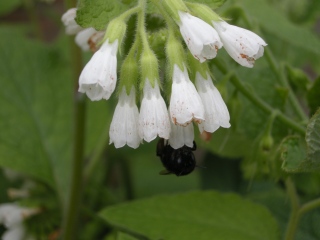Position: Full sun to partial shade
Flowering period: Spring to early summer
Soil: Moist, well drained
Eventual Height: 1.2m
Eventual Spread: 0.8m
Hardiness: 4a, 4b, 5a, 5b, 6a, 6b, 7a, 7b, 8a, 8b, 9a, 9b
Family: Boraginaceae
Symphytum officinale is a herbaceous perennial herb. Its mid-green basal leaves are petiolate to ovate, hairy and are up to 60cm long and 20cm broad. Its upper stem leaves are smaller. Its stems are erect and branched. Its numerous bell shaped hermaphrodite flowers are produced at the ends of its stems. The flower colour ranges from pale purple to yellow/ white. Its fruit is in the form of four grey/ brown nutlets. Its roots are stout and deep.
Symphytum officinale, commonly known as Comfrey, Common Comfrey, Boneset, Knitbone and Slippery-root, is native to most of Europe, including the UK. In its native habitat it grows in damp grassy places, ditches and river banks. It has been used historically as a poultice to treat burns and broken bones. This plant propagates easily from root cuttings.
The etymological root of the binomial name Symphytum is derived from the Greek sumfuton ‘to grow together’, as named by Pliny. Officinale is derived from the Latin translating as ‘of the shop’.
The landscape architect may find Symphytum officinale useful in a native wildlife gardens due to its attractiveness to pollinating insects. It may also be planted as a crop, harvested to produce an organic fertiliser from its leaves.
Ecologically, Symphytum officinale is attractive to pollinating insects.
Symphytum officinale prefers moist, fertile, well-drained soils. It tolerates most pH of soil. It prefers moist soils.
Symphytum officinale requires little maintenance. This plant propagates easily from root cuttings.






So many virtue in just one plant !